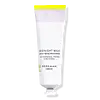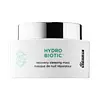What's inside
What's inside
 Key Ingredients
Key Ingredients

 Benefits
Benefits

 Concerns
Concerns

 Ingredients Side-by-side
Ingredients Side-by-side

Water
Skin ConditioningGlycerin
HumectantGlyceryl Stearate
EmollientCetyl Alcohol
EmollientNeopentyl Glycol Diheptanoate
EmollientGlyceryl Caprylate
EmollientSqualane
EmollientPalmitoyl Tripeptide-38
Skin ConditioningCaprae Lac
Skin ConditioningMilk Protein
Skin ConditioningLactose
HumectantBifida Ferment Lysate
Skin ConditioningBakuchiol
AntimicrobialMelatonin
AntioxidantHyaluronic Acid
HumectantIsododecane
EmollientMelia Azadirachta Flower Extract
Skin ConditioningStearic Acid
CleansingGlyceryl Stearate Citrate
EmollientHydroxyacetophenone
AntioxidantPanthenol
Skin ConditioningCoccinia Indica Fruit Extract
Skin ConditioningCarbomer
Emulsion StabilisingAllantoin
Skin ConditioningXanthan Gum
EmulsifyingCaprylhydroxamic Acid
Glyceryl Laurate
EmollientBetaine
HumectantSodium Hydroxide
BufferingCentella Asiatica Extract
CleansingHydroxypropyl Cyclodextrin
MaskingSpinacia Oleracea Leaf Extract
Skin ConditioningSodium Carbonate
BufferingPropanediol
SolventTephrosia Purpurea Seed Extract
Skin ConditioningAcetyl Hexapeptide-8
HumectantGardenia Florida Fruit Extract
Skin ConditioningMaltodextrin
AbsorbentWater, Glycerin, Glyceryl Stearate, Cetyl Alcohol, Neopentyl Glycol Diheptanoate, Glyceryl Caprylate, Squalane, Palmitoyl Tripeptide-38, Caprae Lac, Milk Protein, Lactose, Bifida Ferment Lysate, Bakuchiol, Melatonin, Hyaluronic Acid, Isododecane, Melia Azadirachta Flower Extract, Stearic Acid, Glyceryl Stearate Citrate, Hydroxyacetophenone, Panthenol, Coccinia Indica Fruit Extract, Carbomer, Allantoin, Xanthan Gum, Caprylhydroxamic Acid, Glyceryl Laurate, Betaine, Sodium Hydroxide, Centella Asiatica Extract, Hydroxypropyl Cyclodextrin, Spinacia Oleracea Leaf Extract, Sodium Carbonate, Propanediol, Tephrosia Purpurea Seed Extract, Acetyl Hexapeptide-8, Gardenia Florida Fruit Extract, Maltodextrin
Water
Skin ConditioningDimethicone
EmollientPropanediol
SolventGlycerin
HumectantSodium Chloride
MaskingDimethicone/PEG-10/15 Crosspolymer
Lactococcus Ferment Lysate
Skin ConditioningHexyldecanol
EmollientInulin
Skin Conditioning1,2-Hexanediol
Skin ConditioningSodium Benzoate
MaskingYogurt Powder
PEG-10 Dimethicone
Skin ConditioningButylene Glycol
HumectantTamarindus Indica Seed Polysaccharide
Skin ConditioningSodium Citrate
BufferingCaprylhydroxamic Acid
Tocopheryl Acetate
AntioxidantLavandula Angustifolia Oil
MaskingTrisodium Ethylenediamine Disuccinate
Bisabolol
MaskingCetylhydroxyproline Palmitamide
Skin ConditioningStearic Acid
CleansingHoney
HumectantBrassica Campestris Sterols
EmollientRosa Damascena Flower Oil
MaskingCamellia Sinensis Leaf Extract
AntimicrobialPhenoxyethanol
PreservativeVitis Vinifera Seed Extract
AntimicrobialBoswellia Serrata Extract
Skin ConditioningHoney Extract
HumectantChlorophyllin-Copper Complex
AntioxidantAspalathus Linearis Extract
Skin ConditioningSaccharomyces Polypeptides
Skin ConditioningWater, Dimethicone, Propanediol, Glycerin, Sodium Chloride, Dimethicone/PEG-10/15 Crosspolymer, Lactococcus Ferment Lysate, Hexyldecanol, Inulin, 1,2-Hexanediol, Sodium Benzoate, Yogurt Powder, PEG-10 Dimethicone, Butylene Glycol, Tamarindus Indica Seed Polysaccharide, Sodium Citrate, Caprylhydroxamic Acid, Tocopheryl Acetate, Lavandula Angustifolia Oil, Trisodium Ethylenediamine Disuccinate, Bisabolol, Cetylhydroxyproline Palmitamide, Stearic Acid, Honey, Brassica Campestris Sterols, Rosa Damascena Flower Oil, Camellia Sinensis Leaf Extract, Phenoxyethanol, Vitis Vinifera Seed Extract, Boswellia Serrata Extract, Honey Extract, Chlorophyllin-Copper Complex, Aspalathus Linearis Extract, Saccharomyces Polypeptides
Ingredients Explained
These ingredients are found in both products.
Ingredients higher up in an ingredient list are typically present in a larger amount.
Caprylhydroxamic Acid is a chelating agent.
Chelating agents help prevent metal ions from binding to other ingredients. This helps prevent unwanted reactions and effects from using the product.
Caprylhydroxamic Acid is often used with natural antimicrobial products as an alternative to preservatives.
Learn more about Caprylhydroxamic AcidGlycerin is already naturally found in your skin. It helps moisturize and protect your skin.
A study from 2016 found glycerin to be more effective as a humectant than AHAs and hyaluronic acid.
As a humectant, it helps the skin stay hydrated by pulling moisture to your skin. The low molecular weight of glycerin allows it to pull moisture into the deeper layers of your skin.
Hydrated skin improves your skin barrier; Your skin barrier helps protect against irritants and bacteria.
Glycerin has also been found to have antimicrobial and antiviral properties. Due to these properties, glycerin is often used in wound and burn treatments.
In cosmetics, glycerin is usually derived from plants such as soybean or palm. However, it can also be sourced from animals, such as tallow or animal fat.
This ingredient is organic, colorless, odorless, and non-toxic.
Glycerin is the name for this ingredient in American English. British English uses Glycerol/Glycerine.
Learn more about GlycerinPropanediol is an all-star ingredient. It softens, hydrates, and smooths the skin.
It’s often used to:
Propanediol is not likely to cause sensitivity and considered safe to use. It is derived from corn or petroleum with a clear color and no scent.
Learn more about PropanediolStearic Acid is a fatty acid. It is an emollient, emulsifier, and texture enhancer.
As an emollient, stearic acid helps soften skin. It aids the skin's protective barrier by preventing water loss. It also provides a gentle cleansing effect without stripping away natural oils.
Stearic acid may also be used to enhance the texture of products. It can add volume and stabilize ingredients such as water and oil. This can help water and oil ingredients from separating.
Sources of stearic acid include animal or vegetable fats/oils such as coconut or shea. It can be naturally found in butter, cocoa butter, shea butter, vegetable fats, and animal tallow.
This ingredient may not be Malassezia folliculitis, or fungal-acne safe.
Learn more about Stearic AcidWater. It's the most common cosmetic ingredient of all. You'll usually see it at the top of ingredient lists, meaning that it makes up the largest part of the product.
So why is it so popular? Water most often acts as a solvent - this means that it helps dissolve other ingredients into the formulation.
You'll also recognize water as that liquid we all need to stay alive. If you see this, drink a glass of water. Stay hydrated!
Learn more about Water